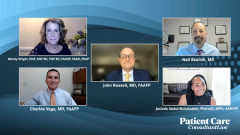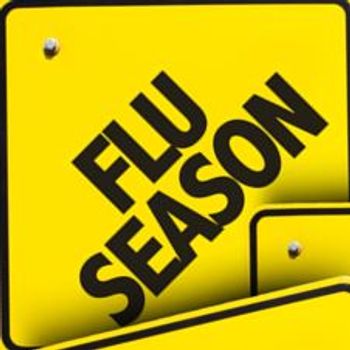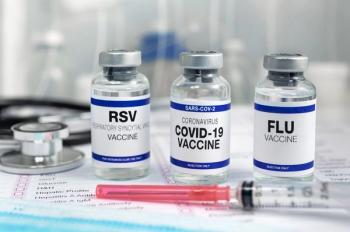
Vaccination Strategies Practice Pearls And Key Take Aways
Drs John Russell, Jacinda Abdul-Mutakabbir, Charles Vega, Wendy Wright, And Neil Skolnik provide their practice pearls and key thoughts on how to vaccinate their patient populations in the upcoming influenza season.
Episodes in this series

John Russell, MD, FAAFP: So, now we're going to kind of wrap up with a few pearls. So, Chuck, what would you say are the main takeaways from the current vaccine guidelines and recommendations? And how can health care providers effectively incorporate them into their day in, day out practices?
Charles Vega, MD, FAAFP: Well, thanks. First, I really appreciate the discussion. So many great points and very patient-centered and community-centered as well in our discussion today. So just to summarize, you know, the flu vaccine should be applied in 99.9% of individuals above the age of 6 months in the United States. I really appreciate that the different perspectives about vaccine hesitancy and putting it in the context of COVID-19 and vaccine fatigue overall. But we just keep trying, because if your patients already have that foundation of trust, I have had breakthroughs with vaccines where patients denied the vaccine for years, despite my best efforts. And then just for some reason, many times they can’t explain it themselves, decide to make a change and make a switch and then realize the vaccine, you know, was well-tolerated, that they didn’t have any significant severe adverse events and they come back and get it again next year.
John Russell, MD, FAAFP: So, Wendy, for you, there’s an awful lot of influenza vaccine misconceptions out there. How do you address that with your patient population?
Wendy Wright, DNP, ANP-BC, FNP-BC, FAANP, FAAN, FNAP: …I try to again be concise and be strong in my recommendation. If they told me something. If they say, “I'm not going to get the vaccine,” [I say,] “Tell me what's standing between you and the vaccine,” and then I will ask them permission to give them information that is more accurate than what they're presenting to me. And so there is a lot of misinformation out there, but honestly, the flu vaccine is one of the easiest vaccines if people would just let us get it into their arms. You don't need 2 pages to explain it like the CDC [Centers for Disease Control and Prevention] [and] ACIP [Advisory Committee on Immunization Practices]. It's simple; 6 months of age and older. Unless you've got a true contraindication, you ought to be vaccinated. It's as simple as that.
John Russell, MD, FAAFP: And JAM, we started our conversation today and you're talking about your passion for at-risk populations. How do we increase influenza vaccine across the board, and especially in some populations, that that uptake has been a lot slower?
Wendy Wright, DNP, ANP-BC, FNP-BC, FAANP, FAAN, FNAP: Right. 100%. Thank you so much for that question. For me, I think that there is beauty in, us as health care providers, leaving the ivory tower and going into the community. And I think that Chuck really hit upon this, really prioritizing accessibility. So, in my research, in my practice, I really focused on prioritizing pharmacoequity, but more so from a vaccine accessibility standpoint, but looking at accessibility as being twofold. So, 1 is really accessibility to information. So, when we think about special populations and I work with racially and ethnically minoritized communities who are more likely to have chronic comorbidities, who are more likely to have just these really bad diseases … that influenza can exacerbate. I'm really looking at, “Okay, how can I make sure these folks get the vaccine, but more importantly, how can I make it so that is their decision?” So, I think that we have to think about access from the aspect of really creating that accessibility to and increasing vaccine literacy. So, 1 part of what I do is I actually provide vaccine education in now taking of taking the trust that everyone talked about that I've earned from the Black community with COVID-19 myself, and I partner with the community organization, and we're moving forward and we're providing information on influenza. So, as an additional component and really focusing on the accessibility after we provide the information, so, to increase vaccine literacy. Then we provide access to the actual vaccines. …I think it's beauty in really just us thinking about how can I make these special populations or how can I think about these marginalized groups or these folks that are high risk? How can I ensure that they want to receive the vaccine? But more importantly, how can we give back the agency that's required to go ahead and do this? So really, we have to consider providing education and really empowering the community with the impact that flu has on them. But more importantly, how is it that these vaccines work to make sure that we're protected and then too, let's put these vaccines within the communities to make it even easier? Like Wendy said, we don't want to leave it to chance whether they get the vaccine. We want to make sure it’s there, it’s easy and they leave with something in their arms. …I think the biggest takeaway that we can have from this program with all these amazing experts is how can we best serve our communities and really make sure that we bring all the knowledge that we have pertaining to the flu and we make it so that the most marginalized person can receive it, can have it, and then they can go ahead and they can be vaccinated themselves.
John Russell, MD, FAAFP: That's great. Neil, do you have a quote to end those with?
Neil Skolnik, MD: You know, JAM, I love what you said and when you said, “They will decide it themselves.” And actually, John reminded me of one of my favorite leadership quotes, which is an ancient quote where they said, “When the leader is done, the people will say they did it themselves.” And JAM, you are so right; it's about trust. It's about clarity of the messaging. It's about letting people know the consequences they didn't think about. And then when we're done, they will come to their own conclusion and feel they made their best decision.
John Russell, MD, FAAFP: Well, it was great being with you all today; we learned a lot. I think we moved the needle on education. So, Neil, Chuck, JAM, Wendy, thank you so much for being here today and helping for this topic that are so near and dear to all of us. Thank you for watching this Consultant Live™. If you enjoyed the content, please subscribe for 1 of our e-newsletters to receive upcoming programs and other great content right in your inbox. Thanks for joining us.
Transcript is AI-generated and edited for clarity and readability.
Newsletter
Enhance your clinical practice with the Patient Care newsletter, offering the latest evidence-based guidelines, diagnostic insights, and treatment strategies for primary care physicians.



















































































































































































































































































